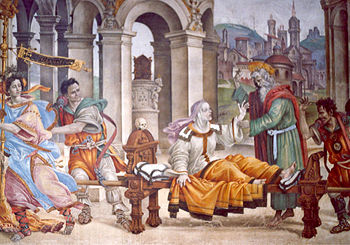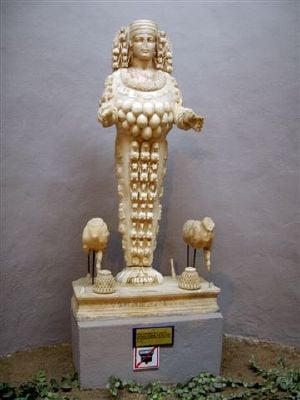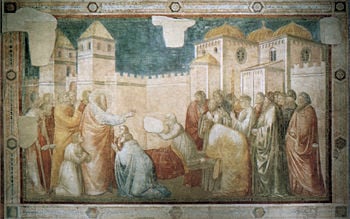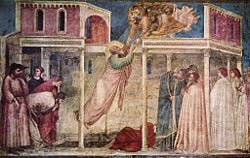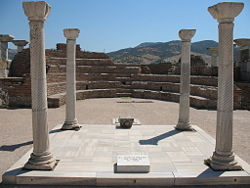Difference between revisions of "Acts of John" - New World Encyclopedia
m (→References) |
m (→References) |
||
| Line 90: | Line 90: | ||
==References== | ==References== | ||
*Bremmer, Jan N. ''The Apocryphal Acts of John''. Studies on the Apocryphal Acts of the Apostles, 1. Kampen, The Netherlands: Kok Pharos, 1995. ISBN 9789039001417 | *Bremmer, Jan N. ''The Apocryphal Acts of John''. Studies on the Apocryphal Acts of the Apostles, 1. Kampen, The Netherlands: Kok Pharos, 1995. ISBN 9789039001417 | ||
| − | *Mead, G. R. S | + | *Mead, G. R. S.'' Gnosticism from the Acts of John''. [Kila, Mont.?]: Kessinger Pub, 2006. ISBN 9780766196841 |
*Schneider, Paul G. ''The Mystery of the Acts of John: An Interpretation of the Hymn and the Dance in Light of the Acts' Theology''. San Francisco: Mellen Research University Press, 1991. ISBN 9780773499508 | *Schneider, Paul G. ''The Mystery of the Acts of John: An Interpretation of the Hymn and the Dance in Light of the Acts' Theology''. San Francisco: Mellen Research University Press, 1991. ISBN 9780773499508 | ||
Revision as of 03:46, 18 October 2008
The Acts of John is a second-century collection of Christian-based narratives and traditions, relating the travels and miraculous deeds of John the Apostle, one of the three closest disciples of Jesus. Together with the Acts of Paul, it is considered one of the most significant of the apostolic Acts in the New Testament apocrypha.
The Acts of John describes journeys of John to Ephesus, filled with dramatic events, romantic episodes, miracles such as the collapse of the Temple of Artemis, and well-framed melodramatic speeches. It may have originated as a Christianized wonder tale, designed for a Hellenic audience, and literary critics consider it to fall in the genre of Romance set in a Christian context.
The work was rejected as heretical due to a section containing teachings of a Gnostic or docetic nature, in which Jesus is depicted as not have a normal human body and as not truly suffering when he was on the Cross. Many of the legends contained in the Acts of John, however, survived in Christian tradition and art.
Introduction
A large fragment of the Acts of John survives in Greek manuscripts of widely varying date. Two particularly segments of the work posed a major problem for orthodox Christian readers because of their docetic imagery and overt gnostic teachings (chapters 94-102 and 109). These resulted in the work's condemnation as heretical, but today many scholars believe these sections to be interpolations, in an otherwise orthodox, though clearly fanciful, work.
Despite being considered as at least partly heretical in church tradition, the Acts of John has been found in many monastic libraries. A number of version, especially those in Latin, seem to have been edited so as to remove any unorthodox content.
The text begins with John traveling toward Ephesus. Its actually beginning has been lost. Some believe that it may have described John's temporary banishment to the isle of Patmos, since the Acts describe him as dying in Ephesus and do not mention his time in exile. On later version of the Acts of John explain that he was exiled to Patmos to Domitian after an episode similar to the one described below with the pagan priest Aristodemus. Another speaks of him experience a shipwreck when he left Patmos, landing at Miletus, and then proceeding to Ephesus.
A number of the episodes contained in the Acts of John were adopted into orthodox Christian. For example the story of the resurrection of Drusiana is depicted in the works well known Christian artists, while the legend of the death assumption of John the Apostle became incorporated into the cult of Saint John at Ephesus. The miracle of the destruction of the Temple of Artemis at Ephesus, meanwhile, would be re-enacted in not-so-miraculous fashion by Saint John Chrysostom and his followers, who destroyed the ancient temple c. 401 C.E.
Summary
Lycomedes and Cleopatra
The beginning of the work is apparently lost, and it open with John, having received a vision, on his way to the city of Ephesus in Asia Minor (today's Turkey). As he approaches the city, the wealthy praetor of Ephesus, Lycomedes, falls at the apostle's fee and beseeches him to help his wife Cleopatra, who is incurably ill. John immediately goes with Lycomedes to his house, where the find Cleopatra not only ill, but clearly dying. Lycomedes expresses his grief in touching tones:
See, Lord, the withering of the beauty, see the youth, see the renowned flower of my poor wife, at which all Ephesus was wont to marvel... The sun in his course shall no more see me conversing with thee. I will go before thee, Cleopatra, and rid myself of life. I will not spare mine own safety, though it be yet young.
John pulls him away, reminds him that suicide is a sin, and predicts "thou shalt receive thy consort again." Lycomedes, however, falls on the floor in despair and dies.
John himself now depairs for his own life, as the Ephesians are likely to hold him responsible for Lycomedes's death. "I know well that they will not suffer me to go out of the house alive," John declares. "Why tarriest thou, Lord? Why hast thou shut off from us thy good promise?" He beseeches God to raise the Lycomedes and Cleopatra from the dead.
The multitude of the people of Ephesus, meanwhile hear that Lycomedes is dead and rush to his house. John prays to Christ: "O physician who healest freely; keep thou mine entering in hither safe from derision." He then turns to Cleopatra and says: "Arise in the name of Jesus Christ... Arise, and be not an occasion unto many that desire not to believe, or an affliction unto souls that are able to hope and to be saved." Cleopatra immediate declares: "I arise, master! Save thou thine handmaid."
The Ephesians are duly impressed by this miracle. Cleopatra then goes with John into her bedchamber and discovers Lycomedes' dead body. She goes into deep mourning, but John instructs her how to resurrect her husband: "Say thou to thine husband: 'Arise and glorify the name of God, for he giveth back the dead to the dead.'" She does as she is commanded, and Lycomedes immediately revives. He then falls again at John's feet and kisses them, to which the apostle responds: "O man, kiss not my feet but the feet of God by whose power ye are both arisen."
Deeply grateful, the couple offer John and his companions hospitality, which they accept. Lycomedes commissions a noted paint to create John's portrait, stimulate a long discourse on the subject of portraiture and perception.
Lycomedes invites John to the public theater. Andromeus, the leading citizen of the Ephesians, meanwhile has challenged John's miracles as the product of trickery, where he miraculously heals several old women. He also delivers a sermon, urging Andromeus and the crowd to moral disciple and asceticism.
John at the Temple of Artemis
John then leads his followers the the Temple of Artemis at Ephesus, one of the Seven Wonders of the World. As it was a festival day, all in attendance were dressed in white, while John alone wore black. Offended by John's impiety, those in attendance were ready to kill him. John courages ascended a pedestal and confronted the bloodthirsty crowd, appealing to the miracles he has wrought as evidence of God's favor. "Ye all say that ye have a goddess, even Artemis," John declares. "Pray then unto her that I alone may die; or else I only, if ye are not able to do this, will call upon mine own god, and for your unbelief I will cause every one of you to die."
The people admit that John's power to perform miracles is the greater, and he then prays: "O God that art God above all that are called gods... show thou thy mercy in this place, for they have been made to err." Immediately the altar of Artemis was torn asunder and her sacred vessels fell over, together with the images seven other deities. "Half of the temple" collapses, and the priest of Artemis dies as a result. A large number of the Ephesians are immediate converted to the worship of the "One God" of John.
Although John had intended to continue on to Smyrna, he remains in Ephesus to teach the new converts and raise them in the Christian faith. In the process he raises from the dead the priest of Artemis, who become one of John's disciples.
John then brings a murderous and adulterous young man to repentance and sobriety, raising the young mans father, whom he has slain from the dead. When the young man castrates himself in remorse, John corrects, teaching him that "it is not the instruments that are injurious, but the unseen springs by which every shameful emotion is stirred." The young man is duly repentant, and becomes John's disciple.
The miracle of the bedbugs
In a particularly amusing tale, John and his companions stay at an inn, where John's bed is infested with bedbugs. Unable to rest, John commands: "I say unto you, O bugs, behave yourselves, one and all, and leave your abode for this night and remain quiet in one place, and keep your distance from the servants of God." John's disciples are amused at this seemingly ridiculous outburst, but in the morning, they discover a huge number of bugs outside the door of John's room, where John has enjoyed a very restful night. At the apostles command, the bug then return to their abode to trouble the next guest.
Andronicus and Drusiana
The story of the noble couple Andronicus and Drusiana demonstrates the tendency of some early Christian literature to view sex, even within marriage, as a detestible act. Here, a certain man characterized as "a messenger of Satan," falls in love with the beautiful Drusiana, who, although married to Andronicus, has devoted herself to celibacy, telling her husband that she would "rather to die than to do that foulness." Now, feeling terrible guilt at having inspired this man to adulterous thoughts, Drusiana herself dies of remorse. This however, did not dampen the lust of that man who desired her, and he bribed Andronicus' steward to open Drusiana tomb in order to have sex with her dead body. He and the stweard proceed to strip the grave-clothes from Drusiana's corpse, but when she is nearly naked a serpent suddenly appears, killing the steward and entwining himself around the fallen body of Drusiana's would-be lover.
The next day at dawn, John and Andronicus appear on the scene, where they encounter a "beautiful youth," apparently an angel, and then discover Callimachus and Fortunatus both dead. John commands the venomous serpent to depart and then raises Callimachus, who confesses his evil intent and repents of his sin. Johns proceeds to raise Drusiana as well, who, though embarrassed to find herself clad in only her shift, rejoices to see Andronicus and to learn that Callimachus no longer lusts after her. After restoring herself to a more modest attire, she asks John restore the steward as well. John empowers Drusiana to revive the steward, which she promptly does. The steward, however, is not grateful, protesting that he would have rather remained dead, and he immediately flees. After celebrating the Eucharist at Drusiana's sepulcher, the group discovers the unfortunate Foruntatus dying a second time from a snake bite. John pronounces his doom: "Thou hast thy child, O Devil."
Docetic teaching
At this point, the texts contains an interlude in which several issues are discussed regarding the nature of Jesus and his suffering. John explains that Jesus appeared during his earthly life in several guises: sometimes as a child, sometimes as himself, and sometimes as an old man. John testifies that when he used to rest his head on Jesus' breast, it was sometimes soft and yielding, and other times hard like stone. Jesus, says John, did not leave footprints when he would on the sandy shore near the Sea of Galilee. John reports seeing Jesus naked on occasion, and that "the earth were lit by his feet and his head touched the heaven." John also says that "Sometimes when I would lay hold on him, I met with a material and solid body, and at other times, again, when I felt him, the substance was immaterial and as if it existed not at all."
Jesus describes the crucifixion to John in a manner suggestive of a transcendent event in which his suffering is something of an illusion: "Nothing of the things which they will say of me have I suffered," Jesus says. "Thou hearest that I suffered, yet did I not suffer; that I suffered not, yet did I suffer; that I was pierced, yet I was not smitten; hanged, and I was not hanged; that blood flowed from me, and it flowed not..." John then relates that "When I went down, I laughed them all to scorn, inasmuch as he had told me the things which they have said concerning him; holding fast this one thing in myself, that the Lord contrived all things symbolically and by a dispensation toward men, for their conversion and salvation."
Final triumph
The text continues with John preaching several homilies the need for holiness and seeking first the kingdom of God before any earthly treasure.
An episode is also related in which John raises from the dead a young man named Stacteus, converts 12,000 Ephesians to the Christian faith, and confronts the pagan arch-priest Aristodemus. "Tell me, Aristodemus, what can I do to take away the anger from thy soul?" asks John. Aristodemus asks John to drink poison. To assure himself that there is no trick, Aristodemus first gives the poison to two condemned criminals, who promptly die. John drinks the poison and suffers no harm, causing many to believe. Aristodemus however, refuses to have faith in John's God until John raises from the dead those who died of the poison before him. John ultimately does so, and Aristodemus finally admits John's greatness, bringing even the Roman proconsul to John to be baptized along with him.
Death
The various manuscripts of the Acts of John differ in many points, including their endings, some of which report his death as follows:
- Having sealed himself in every part... and laid himself down in the trench where he had strewn his garments, and having said unto us: 'Peace be with you, brethren,' he gave up his spirit rejoicing.
Some sources add: "We who were there rejoiced, some of us, and some mourned... And forthwith manna issuing from the tomb was seen of all, which manna that place produceth even unto this day."
Another tradition relates:
"We brought a linen cloth and spread it upon him, and went into the city. And on the day following we went forth and found not his body, for it was translated by the power of our Lord Jesus Christ, unto whom be glory."
And finally:
- "On the morrow we dug in the place, and him we found not, but only his sandals, and the earth springing up like a well."
See also
ReferencesISBN links support NWE through referral fees
- Bremmer, Jan N. The Apocryphal Acts of John. Studies on the Apocryphal Acts of the Apostles, 1. Kampen, The Netherlands: Kok Pharos, 1995. ISBN 9789039001417
- Mead, G. R. S. Gnosticism from the Acts of John. [Kila, Mont.?]: Kessinger Pub, 2006. ISBN 9780766196841
- Schneider, Paul G. The Mystery of the Acts of John: An Interpretation of the Hymn and the Dance in Light of the Acts' Theology. San Francisco: Mellen Research University Press, 1991. ISBN 9780773499508
External links
- Early Christian Writings: Acts of John e-text consisting of 115 brief chapters, translated by M.R. James, and introductory material (1924).
- Glenn Davis, "The development of the Canon of the New Testament": Acts of John
- Gnostic Scriptures and Fragments: Acts of John
- David Trippett, "Gustav Holst (1874-1934)"
- Church Fathers: Acts of John: abbreviated translation of the Latin version
Credits
New World Encyclopedia writers and editors rewrote and completed the Wikipedia article in accordance with New World Encyclopedia standards. This article abides by terms of the Creative Commons CC-by-sa 3.0 License (CC-by-sa), which may be used and disseminated with proper attribution. Credit is due under the terms of this license that can reference both the New World Encyclopedia contributors and the selfless volunteer contributors of the Wikimedia Foundation. To cite this article click here for a list of acceptable citing formats.The history of earlier contributions by wikipedians is accessible to researchers here:
The history of this article since it was imported to New World Encyclopedia:
Note: Some restrictions may apply to use of individual images which are separately licensed.
